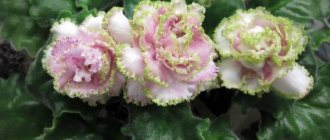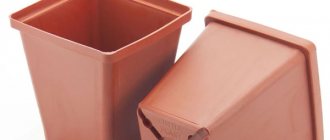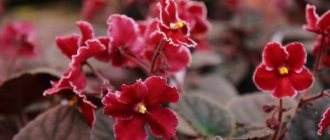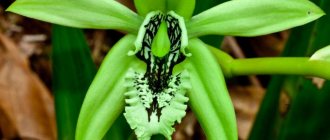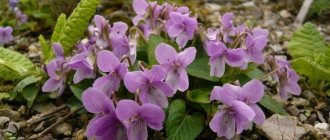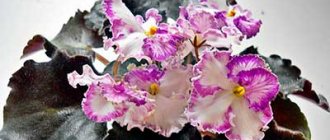Violet is an unpretentious plant that, with proper care, pleases with delicate and lush flowering all year round . But not all gardeners can grow and achieve lush flowering.
The secret to lush flowering is simple - you need to know what mistakes should not be made when growing Zivay violets.
Read the recommendations for caring for the Moreva Zivay variety and following them, the violet will thank you for your care with an attractive openwork flowering dense cap.
Violet Zivay (K. Morev)
Beautiful violet Zivay Moreva.
History of the variety
Variety Zivay is an Uzambara violet , which belongs to the Gesneriev family. It is the selection work of Konstantin Morev. Variety 2006.
Description and photo
Violet flowers:
- Large or medium size;
- Heavily terry;
- Coral-salmon color;
- The edges of the petals are fringed.
The saturation of flowering varies from light to darker and more saturated , depending on the temperature in the room. It blooms for a long time, about three months.
The pompom flowers are complemented by the beautiful and bright variegation of the rosette. The socket is standard in size. On average about 35 cm in diameter. There are many buds, an abundant, dense cap. You can see a photo of the Zivai Morev violet on the right.
Variegation, imprints
A variety with very bright and beautiful variegation. The pink-beige, sometimes tricolor variegation on the dark green leaves captivates the eye . Neat violet rosette:
- The central part is beige;
- Next with pink;
- And the outermost oldest leaves have white variegation.
The rosette of the variety is quite large, the leaves often turn inward .
Attention! With temperature fluctuations and the influence of other factors, the leaves of the variety can become almost white.
The violet leaves have an unusual color.
Sports
The variety sports and loses its variegated foliage . Sometimes, instead of chic salmon pompoms, inconspicuous white inflorescences with a bluish tint appear.
Reviews
Konstantin Ilyich. “This is not the first year that I have been closely following the breeding innovations of my namesake, Konstantin Morev, and whenever possible I purchase his varieties for the collection. All his violets are invariably distinguished by the stability of their varietal characteristics, unpretentiousness and brightness. Sometimes it seems to me that the breeder is too picky about his offspring. Take, for example, “Curly Sue”: a magnificent violet that has all the varietal characteristics; but for Morev it is only a seedling. The author does not want to recognize the “Curly Sue” violet as a variety, although this is his right. But I like the seedling, I included it among my favorites, and this is my right.”
Flower growers are satisfied with the Curly Sue variety.
Sofia Mikhailovna. “ I would like to share my impressions of the violet “Curly Sue”. Recently I was at a flower exhibition, where I noticed a charming and delicate Saintpaulia. Against the background of a juicy, even leaf rosette, a beautiful bouquet of white and pink flowers, very large for violets, stood out. The prints on each petal look like the blush of a little girl who has come running from the cold to the warmth. Looks nice. I purchased the plant, although the florist convinced me that it was not a variety, but a seedling. But I don’t have a professional collection; I grow the violets that I like. And “Curly” is among them.”
Home care
Saintpaulias are capricious plants. For them you need :
- Find the right place;
- Or create suitable conditions in the house for growing them.
Otherwise, under unfavorable conditions, the purchased violet variety Zivay will not take root and will die .
You need to keep an eye on:
- Daylight hours;
- Room temperature.
Then the varietal violet will thank you with lush and abundant flowering .
Proper watering and fertilizing
Water the violet with settled water at room temperature . So that salts do not settle on top of the ground, which will not allow the delicate roots of Saintpaulia to receive normal nutrition.
The earthen ball should always be moist; the soil should not be allowed to dry out , but the top layer should dry out a little. Excessive and unreasonable watering of violets will lead to the formation of root rot, which can provoke the rapid death of the entire plant.
Fertilizing is carried out regularly , during active growth and flowering of violets, and during the dormant period, liquid fertilizing is added to the water for irrigation once every two weeks.
Violets require proper watering.
Advice! In order for the variegation of the Zivai rosette and flowering to be spectacular, violet growers use fertilizer with a high phosphorus content.
When the soil is waterlogged, the variegated variety does not recover as easily as others . Its leaves become covered with brown spots, and the variety can quickly die if excessive moisture stagnates.
Lighting and temperature
For the normal development of children and the growth of an adult rosette, the duration of daylight should be at least 10-12 hours.
The Morevsky variety Zivay, like all variegated varieties, does not like high temperatures; the optimal temperature for it is considered to be 18-22 degrees .
The variety does not like bright sunlight, nor does it like too high temperatures. When exceeding which at the socket :
- The center thickens;
- She stops growing;
- And it can even dry out the resulting buds.
In cool conditions, the Zivay variety feels excellent . The freshness of the flowering remains for at least three weeks.
Air humidity
In winter or summer, violets may suffer from insufficient air humidity . The optimal figure is considered to be 50-60%. Automatic humidifiers are used to increase indoor humidity. Can be used:
Growing Saintpaulia requires moist air.
- Decorative containers with water;
- Or place the pots on trays with wet: Moss;
- Or expanded clay.
What kind of soil does he prefer?
They buy special soil for Saintpaulias. It must be well breathable; for this purpose, baking powder is added to it.
Leavening agents:
- Vermiculite;
- Perlite;
- Foam balls;
- Sphagnum moss.
You can prepare your own soil for Saintpaulia.
Important! Disintegrants are needed so that the soil does not become compressed and the delicate roots of the violet receive enough oxygen.
To prepare the substrate, take 1 part of a baking powder, for example perlite, and mix it with 2 parts of Saintpaulia soil. If the violet grows on wick watering, then even more baking powder is added to the substrate in a 1:1 ratio.
Pruning and hygiene
As the green mass on the rosette grows, juvenile, all asymmetrical and damaged leaves . The stepsons that appear in the sinuses must be removed, otherwise the rosette will grow crooked.
Attention! The variety forms well on its own, so by immediately correctly forming a young plant in the future, an adult rosette will not bring much trouble.
Reproduction methods
Varietal violets are propagated in three ways :
- Rooting a cutting (leaf);
- Stepchildren;
- Rooting the peduncle.
Violet is most often . To preserve the maternal properties of the plant, it is better not to take too old or young leaves for cuttings.
A cutting from the second row is best suited . If the violet is blooming at this time, it is better to choose a cutting from the most beautiful flower that has good doubleness.
Transplant rules, rejuvenation
Grown-up children are transplanted using the transshipment method into a new larger pot when the roots become crowded. But, you should not immediately plant the rosette in a pot that is too large:
- The diameter of the pot should be smaller;
- And the violet leaves should be 2/3 larger than its diameter.
Adult violets that are several years old undergo a re-rooting procedure :
- Trim the elongated bare stem;
- Remove the lower tier of leaves;
- And they are planted in a new substrate in a greenhouse.
The violet needs to be replanted once a year.
After new roots have formed, the plant is taken out of the greenhouse and placed in its usual place .
Diseases and pests of violets of the Blue-Eyed Russia variety
Violet can be affected by many pests. Aphids, flower thrips, mealybugs, scale insects, whiteflies. To prevent the appearance of pests, we treat them with some kind of insecticide once a month. It is useful to know that the treatment must be repeated after a week.
If the Blue Russia violet is attacked by pests, the plant is treated with an insecticide.
This must be done because poisons only affect adults and larvae, but do not kill eggs, which are reliably protected by a dense shell. After some time, young larvae emerge from the eggs. Repeated treatment is needed to destroy these larvae. Without repeated treatment, pests will continue to live and multiply.
It is good to use highly effective drugs of the new generation for treatments, such as Aktara, the solution of which can not only be sprayed, but also spilled onto the soil in pots, Teppeki, Mospilan, Apploud (which has ovicidal properties - it destroys pest eggs).
[adsp-pro-7]
All new generation insecticides can be purchased on special websites on the Internet, even in small packaging. A pest such as spider mites can be destroyed with Fitoverm (a biological product with low toxicity, harmless to humans and animals), Akarin.
Unfortunately, violets are often affected by many diseases, among which the most common are late blight, fusarium, gray rot, and powdery mildew. When diseases appear, it is necessary to treat plants with fungicides such as Ordan, Previkur, Fitosporin, Switch.
If the violet is affected by a fungal disease, the plant is sprayed with a fungicide.
For powdery mildew we treat with Topaz Vectra, Skor. Treatment with fungicides must be carried out for preventive purposes several times a season.
Features of flowering, growth and reproduction
How long does it take to grow an adult plant?
The variety grows quickly. Cuttings of the variety take root well, babies appear within a month and, under good conditions, quickly increase green mass. The first flowering can be seen after 7 months .
Features of flowering in hot and cool conditions
The variegated variety prefers cool conditions . At high temperatures in the room, the beautiful, three-color variegation of the leaves practically disappears.
When strong variegation appears, the rosette begins to lose symmetry and the flowers on it look a little sloppy . On old rosettes this effect increases even more, so this variety is rejuvenated every two years.
What do flower stalks look like?
The peduncles of the variety are erect, and may be slightly adjacent under the weight of three or four buds .
Is it possible to achieve cap flowering?
If you follow all the rules for caring for the variety, it is easy to achieve dense cap flowering from an adult rosette.
Bud lifespan
The buds formed on the peduncles take about a month to open . But the freshness of flowering remains for a long time. Under cool growing conditions, violets bloom for about 3 months.
The variety blooms for up to 3 months.
Persistent cap flowering makes an indelible impression , and complements them with delight from the beautiful variegated foliage. Which hugs delicate salmon pompom buds.
Light
According to the description, the Blue-Eyed Russia violet needs plenty of lighting, but without direct sunlight. South windows are not suitable for the plant. If there is no other placement option, then shade the violet. It is best to place the plant on east and west windows.
In winter, it is recommended to remove violets from cold glass to prevent hypothermia of the roots.
If the plant is not placed on a windowsill, then it must be illuminated. With a lack of light, the violet stretches upward, the color of the leaves is lost, they become soft, and the development of the rosette is disrupted.
In order for the plant to develop correctly, it is provided with 14-16 hours of daylight.
